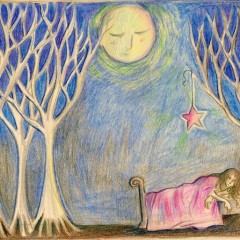When I was about eighteen I fell in love with a band called Morphine. In particular, with their album The Night, an album as mystically dark and nocturnal as its name. Using a palette of low voice, low cello, low drums, low piano and moody, mournful backing vocals, the album conjured visions of parties fuelled by green chartreuse and relationships fraught by peril and separation, while a lone saxophone oozed and canoodled in the middle range. The singer and bassist, Mark Sandman, had died, aged 49, of a heart attack while onstage, in 1999. The Night was released after his death.
From the very first opening bars of the eponymous title track you’re removed, mercilessly, to a muted, magical landscape full of unknown, alluring terror. ‘It’s too dark to see the landmarks, and I don’t want your good-luck charms/ I hope you’re waiting for me, across your carpet of stars,’ sings Sandman, to someone named Lila. Over the years that I listened to and loved this song, I became interested in Lila, this mysterious addressee, weaver of spells, a ‘bedtime story that keeps the curtains closed.’ Who was she, and why did she hold such dark power?
I have to confess that I did not realise that Lila was most probably spelt Lilah and derived from the Hebrew word for night*; if I had known, I might have read into the lyrics a more metaphorical context for the song. Perhaps ‘Lila’ was not a person at all, but more an expression of the writer’s relationship with the unknown, the hidden parts of the world that he longed to see more clearly. But we bring to every text our own thoughts and experiences, and what I heard, for a long time, was one side of what seemed to me to be a real, human relationship.
And the more I thought about it, the more I longed for ‘Lila’ to be able to reply.
Thus, my song Lila was born.

‘You’re the night,’ says The Night. ‘You’re a folk tale; the unexplainable.’
‘I am not the night,’ says Lila. ‘No fairytale of a witch in an ivy cave.’
‘You’re everything that we can’t see.’ says The Night.
‘No,’ says Lila,’ I am not the one.’
As this new, voiced Lila grew, and the song grew with her (low piano, low drums), I realised she needed to do more than refute the accusation. And so, after the second chorus, Lila undergoes a transformation: she is not the night, certainly – rather, her interlocutor is. He may claim to be lost ‘off the map where the wild things grow’, but it is she, Lila, who ‘sees snakes in prisonlike trees [whose] tendrils beckon like all Hell’s furies’ and that she is the ‘victim’ of ‘bedtime stories.’ Instead of a resolute ‘no, I am not the one,’ the song ends in ‘yes you are, you’re the night, yes you are.’ I wanted to explore how when we dissect a relationship we tend to assume that we are the only injured party; it is harder to accept that there may be many faults on both sides.
But it’s funny, now, to listen back to The Night, the original inspiration for Lila, because I no longer hear in Sandman’s voice a man who is angry, or accusatory. If anything, the refrain of ‘you’re the night’ has a balmy candour that suggests a passionate willingness to fall head-first into uncharted waters. I wish I knew what he meant, and whether there really was a Lila(h); for me, when I perform the song, there is.
*Later, I discovered that Morphine also released Lilah II on their album At Your Service.
